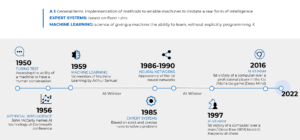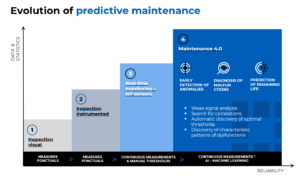AI and predictive maintenance, nothing new?
28 February 2022Yes, AI can do a lot, but not just anything or any way! Let’s go back to the basics.
We have come a long way from the beginnings of artificial intelligence in the 1930s to the arrival of expert systems in 1980 and Machine Learning algorithms as we know them in 2022!
But what has changed and why? Applied to industry, what impact for maintenance? What scientific and technical challenges for what benefits in the field?

Expert systems
The increasing power of processors has enabled computer tools to model the reasoning of a human expert to solve complex problems: expert systems. In concrete terms, they need input data, a strict and precise rule base, and an inference engine to make it all work.
But, as good as they are, they only automate and accelerate the resolution process decided by the human with fixed rules from the start. In other words, the system does not evolve: it is based on known rules and issues.
In industry, expert systems are widely used, particularly in the field of operational safety (control and command tools, system diagnostics based on fault trees, etc.). But these systems are not designed to identify new phenomena or to go beyond human knowledge and expertise.
Machine Learning
This is where Machine Learning comes into its own. The multiplication of calculation capacities and available data has changed the situation. More than just problem solving, Machine Learning allows an algorithm to develop its own solving rules from provided data (real data, not fixed business rules).
Based on models that evolve over time and analyse a variety of real-world parameters, Machine Learning technologies are particularly interesting for maintenance because:
« if some failures are recurrent and known, many are new! It’s therefore necessary to be able to deploy artificial intelligence (AI) solutions capable of identifying new abnormal behaviours and diagnosing new types of malfunctions » explain Jean-François BOUIN President and co-founder of DiagRAMS.
This makes it possible to monitor operating deviations over time, to detect certain weak signals announcing breakdowns, sometimes unprecedented, and to understand the evolution of the health of its machinery.
Industrial data: from big data to smart data
To be effective, AI techniques must respond to the specificities and challenges of the industrial context: little failure history available, variety of context of use of the equipment, multi-source data (machine sensors, business software, automats…), multiformats (structured, unstructured), different types of data (real, categorical, functional, missing data…), with a greater or lesser degree of certainty (declarative data vs. objective measures)… which can quickly represent a large amount of data.

Beyond the quantity of data available, the real challenge is to identify the data that is really relevant for the analysis (big data vs smart data). So we don’t try to collect everything (this would represent a significant storage cost) but to extract from the global data set the interesting information related to the issue at hand.
The frequency of data acquisition should also be taken into account in order to have access to the right granularity of information. For example, if we wish to analyse a machining phase that lasts a few seconds, it is essential to have an acquisition frequency that is sufficient to represent the variations that can occur during this machining phase.
Machine Learning methods must address different issues to ensure the best performance in predictive maintenance: identify informative data, extract the full value of the weak signals they contain without transforming or erasing important information, search for multi-sensor correlations (multivariate analysis), discovery of characteristic patterns of operation.
In concrete terms, what can we expect from AI for maintenance?

Predictive maintenance is not new. On the other hand, AI and Machine Learning methods are enabling the development of Maintenance 4.0, which offers a particularly suitable response to the challenges and specificities of the industrial context.
It goes beyond the limits of corrective and preventive maintenance to intervene according to the actual state of its equipment and not a theoretical schedule. It helps to reduce emergency interventions and intervene just in time.
Benefits? Anticipating failures, automatic detection of both recurring and new malfunctions, plan maintenance interventions, maximise the time of use of the parts, control the availability rate of its equipment…, So many reasons why manufacturers are turning to predictive maintenance solutions incorporating the latest Machine Learning technologies.


